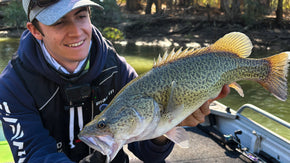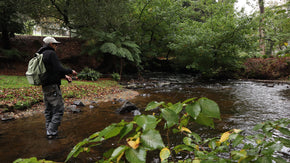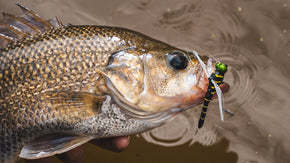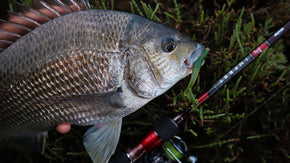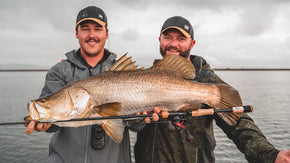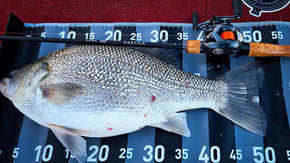Posted 09th December 2022
Landbased Series- South East Queensland


By Robert Thornton
Fishing without a boat might sometimes seem like a disadvantage, but with good preparation and a smart approach, landbased anglers can still nail quality fish. As a bonus, there’s no boat clean up or maintenance to worry about!
If you’re new to fishing, chances are you don’t have a boat, and while this does limit some options, it opens up others. South East Queensland has a stack of great landbased spots that offer a range of bread and butter species, as well as a few surprises here and there. The key to becoming a good landbased angler is to get yourself set up properly, and to use the fact that you’re on your feet to your advantage.
This blog will look at a few spots in Brisbane and the Gold Coast, the species that live there, and how to catch them on foot! But first, let’s get our kit sorted!
 Landbased Kit
Landbased Kit
The nice thing about landbased fishing is that you don’t need much gear. Bear in mind that you are limited in what you can carry, so it makes sense not to overload yourself. With that said, it’s important to try and cover your bases as thoroughly as you can with the limited gear you can lug around with you.
Anyone looking to do just a bit of general luring will find that Daiwa’s Guide Waist Bag and Sling Bag are affordable tackle storage options if you want something simple and easy.
Having an organised tackle stash goes a long way toward making your landbased fishing experience enjoyable, and not having to spend time untangling lures and other bits and bobs in your kit will mean you spend more time fishing. The Soft Plastic Wallet and Egi Wallet are designed to store soft plastics and squid jigs respectively, and not only do they make access to your tackle simpler, they also ensure they aren’t getting damaged in a loose bag or tackle box. These wallets can be stored inside any bag for quick access.
Some landbased anglers like to carry a bit of extra gear to keep their options open, and for this approach there’s no better bit of kit than the Guide Backpack. Really adventurous landlubbers can actually combine the Guide Backpack, Guide Waist Bag and Guide Phone Pouch in a bag on bag system!
Of course, Daiwa have a range of storage and luggage options perfect for landbased fishing, so make sure you check them out!
Landbased Tackle
Selecting tackle for fishing on foot is simple. Light spin rods that are 7ft or longer are better than shorter rods, as being on land will mean you sometimes have to cast further. Longer rods are also handy if you need to stand back from the water a little bit, which is a common scenario when shore fishing anywhere.
Given that most landbased fishing spots in South East Queensland offer species like bream, flathead, whiting, squid, tailor, trevally and bass, it’s a good idea to keep your outfit light.
The 20 Infeet spin rod range is perfect for general land-based luring, particularly the light and ultra light 752LFS and 762ULRS models, as they are designed for casting small lures out a long way.
Reels in the 1000-2500 size range are fine, just be sure to spool them up with light but good quality mainline. J-Braid Grand 8 in 6lb is a happy medium – light enough to get bites from skittish fish, but not too light that you’ll be breaking off all the time. If you’re fishing in areas where there is obstruction between you and the water, or you are needing to lift your captures from the water to where you’re standing, 10lb might be better.
Fluorocarbon leaders are standard in most lure fishing, and it’s no different from the land. Fluorocarbon is less visible in the water to fish, and when working shallow shoreline areas this is a huge advantage. Most species can be tackled with 8-12lb leader, but again, you can scale it up if fishing from tricky locations.
 Lures
Lures
Shore game fishing is about packing light but also covering your options, and the key is to choose presentations that are versatile. Having lures to cover every part of the water column will always put you in with a better chance. Being well-equipped means you can adapt quickly if the conditions change, plus you’ll have the freedom to target a greater range of species!
When covering the surface, choosing lures that imitate small prawns and baitfish as they flee danger is the way to go, and for this you can’t go past the Infeet Slippery Dog 80F – this lure even sounds like a prawn! To create more noise, particularly if there’s a bit of chop on the water or you need something to stand out in dirtier water, the Steez Popper 50F is perfect for creating that extra commotion.
Moving slightly deeper, for covering the water just under the surface there’s no better all-round estuary hardbody than the Infeet Rollin’ Crank MR and DR. Cranking these small crankbaits over shallow sand and rubble flats will turn the heads of bream, whiting, flathead, plus bass in the nearby freshwater creeks.
To imitate larger, longer prey items, the Pro Double Clutch 75 is an awesome tool for methodically working the estuaries from the shore. This suspending bait will hang there tantalisingly to tempt even the fussiest of eaters.
For soft baits, the Bait Junkie 2.5 Inch Grub and Minnow are incredibly useful to have on hand. Both can be slow-rolled through deeper holes, and are a great ‘searching bait’. These plastics have been refined to give off the strong tail vibration, and can be enhanced further (especially for bass) by rigging them on a Jig Spinner SS!
For working the bottom level, vibration and blade baits are a commonly called-on tool, and Daiwa’s Steez Metal Vibe has this covered. These baits are designed to be slow-rolled or hopped, which is perfect for the land-based angler. They also feature an enticing action on the fall instead of spiralling like other blades.
Squidders are well catered for with the Emeraldas range. For fishing new water, an all-rounder like the Emeraldas Nude 25 squid jig is excellent for shore-based fishers. With the Agorig Sinker system and the EG-Snap, the user can modify the sink rate, meaning one jig can do the job of several!
 Brisbane Fishing Spots
Brisbane Fishing Spots
Brisbane anglers have a great selection of landbased fishing spots to choose from, and by utilising some of the gear outlined above, you’ll be able to experience them for yourself!
Pumicestone Passage
This section of water between Bribie Island and the mainland is only just over an hour’s drive from Brisbane’s CBD, and boasts vast stretches of bank accessible on foot! What’s more, the island is connected to the mainland via a bridge.
The sank banks at Toorbul along the Esplanade and even around the boat ramp are great places to throw lures for bream, whiting and flathead. High tide will see these flats covered and this is a good time to throw topwaters and crankbaits. As the tide recedes, soft plastics and vibes worked through the holes between the weed are deadly on the flathead in the area.
Directly across the passage on the Bribie side, White Patch and Banksia Beach offer heaps of spots to duck off White Patch Esplanade for the same species, plus the odd tailor during winter. This bank sits closer to deep water, and offers more comfortable wading due to the firm sand underfoot.
The Bongaree Jetty in Bongaree is an underrated landbased fishing spot. While it sees a lot of traffic, there’s no denying that this structure offers landbased anglers access to fish less commonly caught from the shore. Species such as trevally, tailor, bonito, mac tuna, and school and spotted mackerel can all be caught from this jetty at times. If you’re passing through, it’s worth having a few casts from the end of the jetty. If the fishing’s no good there’s plenty of cafes nearby!
Moreton Bay
Moreton Bay is a large area, and a variety of species can be caught from its many vantages. Sandgate and Brighton offer excellent bream fishing, and anywhere along Flinders Parade is a good spot to roll crankbaits along the rock walls at high tide, particularly with a bit of wind chop.
Shorncliffe Pier and nearby Cabbage Tree Creek (along Allpass Parade) can offer up good fishing at times, particularly for whiting and flathead, with tailor becoming common through winter. The seafood available from the shops along here is amazing as well, and a great back up if you’re food gathering mission fails.
Jumping on a foot barge at Cleveland and heading across the bay to North Stradbroke Island is a great way access some of the less fished parts of Moreton Bay. The fishing jetties at Dunwich and One Mile offer incredible fishing at times. Species such as trevally, tailor, bonito, mackerel, mac tuna and even kingfish commonly venture in close enough to cast at. Underneath the jetty, mangrove jack, estuary cod and small reef species are taken on a regular basis, while bream, whiting and flathead abound on the nearby flats. Additionally, the adjacent shallow areas (particularly between Dunwich and One Mile) offer some of the best landbased squidding available anywhere!
If you don’t wish to board a barge, the fishing in Cleveland and Ormiston can sometimes be as good as on the island. Raby Bay Foreshore Park is a good area to find bread and butter species from the many rock walls that jut out into the water, plus the canals hold species such as squid, mangrove jack, trevally, estuary cod and queenfish, as well as the usual bream, whiting and flathead.
Gold Coast Fishing Spots
The Gold Coast is known Australia-wide for its variety of fishing options, and it’s no different for the landbased angler.
Paradise Point Beach at the mouth of the Coomera River is an easy-to-access spot where bream, whiting and flathead show up regularly, along with trevally and tailor when there’s enough bait running through the system.
The area known as Bums Bay (accessible via Connor Hurley Beach along Seaworld Drive) is a very peaceful spot to wade and flick lures out over the weed flats. Bread and butter species are the main target, however through winter small pelagic such as trevally, queenfish, rat kingfish and tailor can arrive en mass. Squid also like to mooch over the seagrass in this area.
The nearby Gold Coast Seaway and jetty at The Spit can both become quite crowded at times, but if you can access either of them during quieter periods they can offer great fishing for smaller pelagics. Tailor are a regular capture in this area, but so too are trevally, tarpon, rat kingfish and queenfish. Small soft plastics, topwater lures and metal slices are the lures to have on hand if fishing the Seaway and Spit. Anglers should practise caution if fishing from the end of the breakwall due to the swell that batters the rocks.
 Gold Coast Freshwater
Gold Coast Freshwater
The Gold Coast also offers excellent freshwater fishing for bass during the warmer months, and most of the rivers and creeks that feed the Broadwater hold populations of our favourite bronzed battlers.
Bass will start to show up in the areas upstream of the M1 bridges in the Logan, Albert, Coomera, Pimpama and Nerang rivers, and anywhere you’re able to push down through the scrub to get a cast in is a good spot. Even if the water is a bit brackish, bass will still hold up in these places, plus you can expect by-catch such as bream, flathead, tarpon and the occasional mangrove jack! Following any large rain event that sees Hinze Dam spilling, the few kilometres of water below the dam can offer truly excellent bass fishing.
A mixture of small topwater lures, crankbaits, jerkbaits and soft plastics (with or without a Jig Spinner SS) will cover your options. For best results, head down early morning or late afternoon. Watch out for snakes, but enjoy the scenery!
Wrap Up
So, as you can see, landbased anglers in South East Queensland can have it pretty good if they do some legwork. The range of species on offer makes this area a shore game anglers’ paradise, and if you kit yourself up intelligently, there’s no reason why you can’t cash in on this bounty as well!








